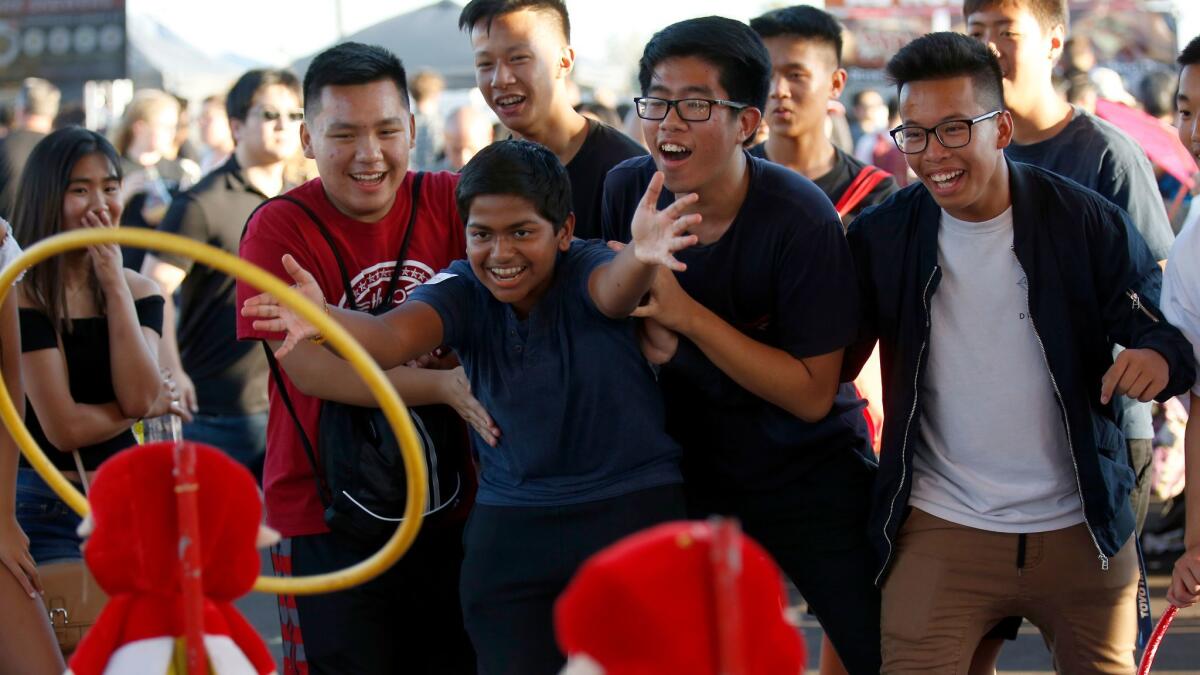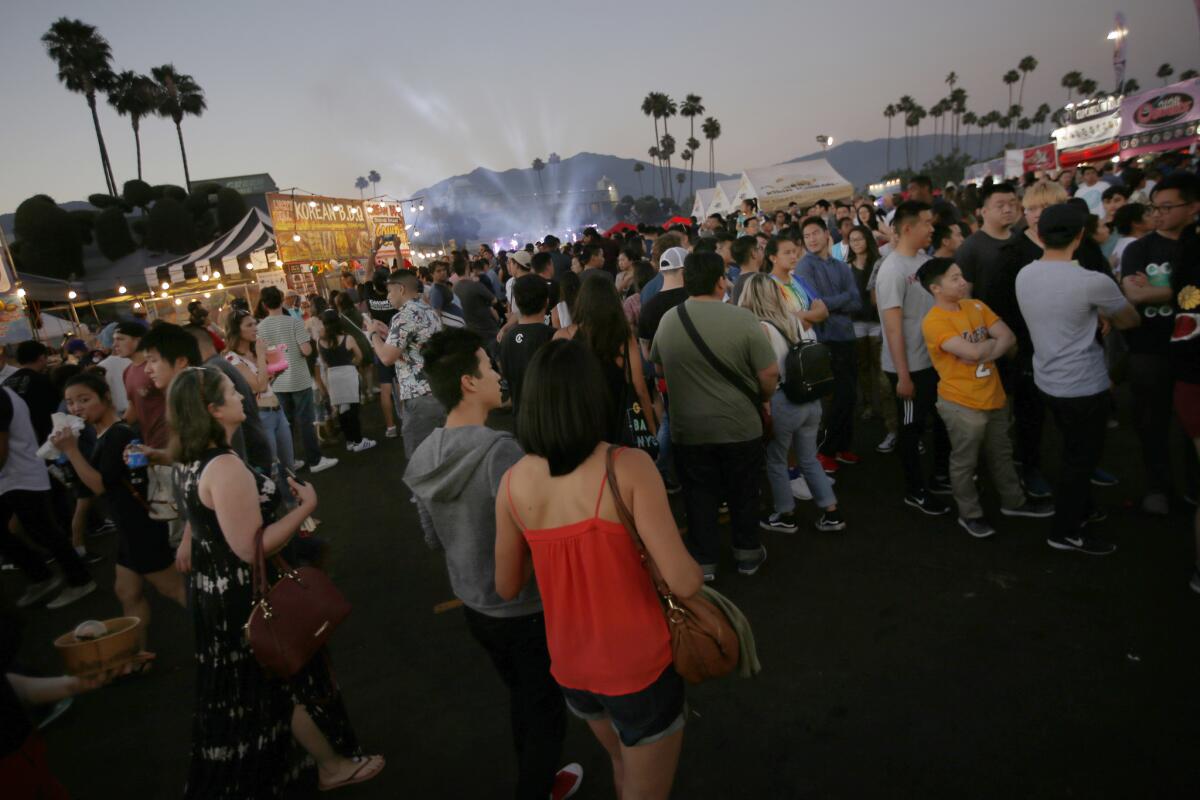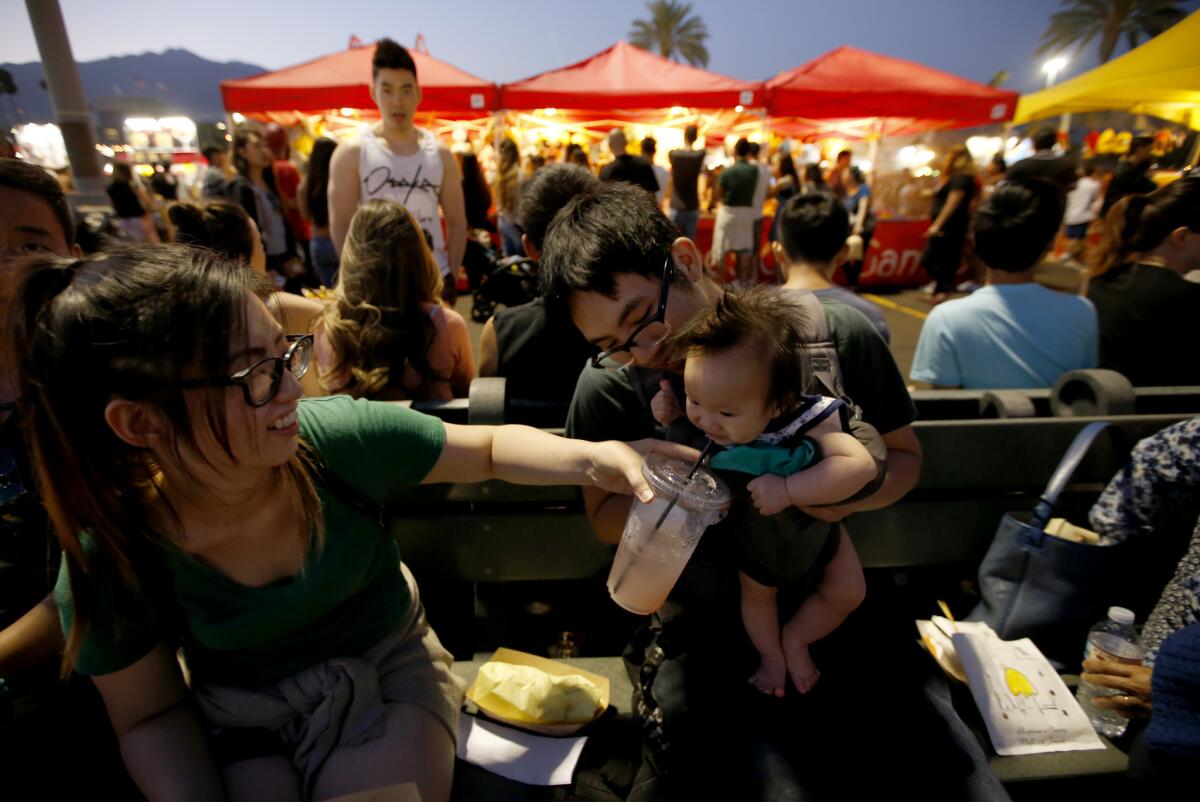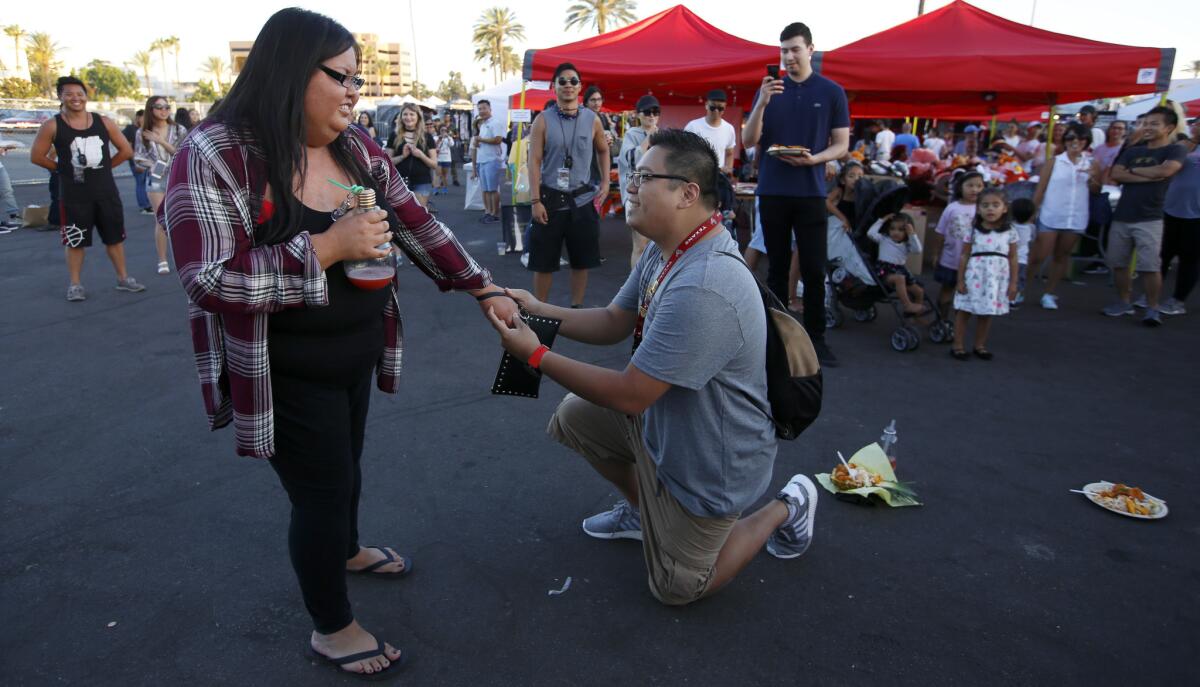From wonton nachos to boba tea in IV-drip bags, 626 Night Market continues to evolve in its sixth year

Lured by “sushi donuts” and other outlandish food items in his social media feeds, Jobel Hernandez drove to the 626 Night Market and waited 45 minutes for “wonton nachos” — Chinese wonton chips topped with carne asada, pork and sauces.
Before that, he split a halved-watermelon filled with Taiwanese shaved ice with a friend and slurped down some ramen. By that point, the 19-year-old had spent about two hours of his Friday night waiting in line, but “the food is worth it,” he said.
Several times a year, more than 100,000 people converge on a lot outside the Santa Anita Racetrack in Arcadia to eat, dance, shop and, yes, wait in lines. The 626 Night Market, entering its sixth year, has become a place where the many parallel universes of the San Gabriel Valley intersect.
Inside the festival on its opening weekend, a group of Asian, black and Latino dancers formed a circle during a hip-hop remix of Kurtis Blow’s “The Breaks,” their shouts mingling with the Chinese karaoke stylings of a woman singing out of the back of a nearby truck.
At a stage on the other side of the festival, partygoers in the crowd pump their fists to the beat of EDM music as a bartender mixes cocktails with the Korean alcohol soju. There are Asian dads in cargo shorts and flip-flops munching on Mexican roasted corn, Latina teenagers lining up for pho tacos and gaggles of Asian girls in fancy shoes and summer dresses clutching selfie sticks.

“For people who grow up here, it’s like a hangout place,” said Kirelem Wu, 19, of San Gabriel. “You always run into friends.”
The original night market began in 2012 when founder Jonny Hwang attempted to import the Taiwanese night markets of his home country to America. He selected a location in Pasadena and branded his idea with “626” — the area code for the San Gabriel Valley and a local Asian American cultural signifier that was increasingly being appended to online screen names, screen-printed on clothes and even inked as tattoos.
The first few events were flooded with attendees, and the festival acquired a reputation for punishingly long lines that it has never shaken. The market’s organizers eventually brought the festival to Orange County and downtown Los Angeles, and different night markets appeared in Koreatown, Monterey Park and Long Beach. Night markets now can be found in places like Philadelphia, Minnesota, New Jersey, New York, Vancouver and Atlanta.
Though it began with authentic Asian street food, the 626 Night Market has evolved into an Instagram-centric foodie’s Disneyland in which a simple cup of boba tea feels passé.
At modern-day iterations of the festival, boba comes in plastic lightbulb bottles replete with blinking lightbulb keychains, IV-drip bags, Mason jars with flashing LED ice cubes, baby bottles and illuminated plastic grenades. Ramen appears in burgers, in a grilled cheese sandwich and shaken up in a plastic canister with sauces. Pho peeks out of tacos.
Hwang said the new food offerings reflect a shift from Asian identity to Asian American identity. Beyond capping the number of vendors selling identical products, organizers don’t curate the stalls, allowing the market’s offerings to evolve on their own based on who is able to find an audience.
The result has been a kaleidoscopic sampling of the tastes and trends of contemporary Asian America, Hwang said.
“We could have went straight Asian style, or very Western, but the Asian American experience is somewhere in the middle,” Hwang said.
The night market arrived at a time when Asian American mainstream culture was in its formative stages, Hwang said. Its popularity has grown as local Asian American artists, writers, actors and rappers have found unprecedented audiences, he added, amplified by chatter on social media.

“In the last couple of years, whether it’s through YouTube or food or the Internet, Asian Americans in SoCal have begun to showcase what they’re all about,” Hwang said.
Though the first festival was almost entirely attended by Asian Americans, Hwang estimates that at least 30% of the festival’s attendees this year will be non-Asian. Non-Asian food items such as Mexican-style elote (corn) are gaining audiences and returning each year, Hwang said.
The night market also has become an incubator for San Gabriel Valley youth culture, Hwang said. Kids who grow up studying to be engineers and doctors can try their hands as chefs or DJs for a few nights and discover a new career. Exhibitors such as Mama Musubi, Rakken Tacos and Ridges Churro Bar have launched food trucks, restaurants and online businesses based on audiences they found at the night market. And night market items like the aforementioned “lightbulb” boba often are copied by brick-and-mortar tea cafes in the San Gabriel Valley.

Last year’s festival also saw the launch of Area Reps, a San Gabriel Valley clothing brand featuring T-shirts printed with “626” in English and traditional Chinese characters.
“This has made being a part of your own community not only good, but cool,” said Kenneth Nguyen, founder of Rakken Tacos. “It’s been empowering in some weird way.”
Nguyen was one of the festival’s first vendors and ended up marrying Patricia Huang, one of the festival’s organizers. A few such proposals happen each year at the night market, organizers said.

On Sunday, Steven Ham, 30, drove with his girlfriend, Lisa Thavisay, from Riverside to attend the festival. Ham, who is Cambodian, has come several times and found the atmosphere comfortable and welcoming — important qualities for the question he planned to ask Thavisay, who’s Laotian, that night.
After some takoyaki and grilled shrimp, Ham dropped to one knee by the stage as friends shot confetti cannons into the air while he proposed.
Thavisay, 28, said yes.
Then they got in line for a dessert of rolled Vietnamese coffee ice cream and Taiwanese shaved ice.
Twitter: @frankshyong
ALSO
You can build your own foie gras instant ramen bowls at the new Korean Mkt. in Sawtelle
Where to find clam chowder fries, pizza dumplings and more hybrid foods you'll actually want to eat
Review: Some of the best Hainan chicken in town is in an Arcadia mall
5 great places to (legally) drink beer outside, in and around L.A.
Sign up for Essential California
The most important California stories and recommendations in your inbox every morning.
You may occasionally receive promotional content from the Los Angeles Times.








